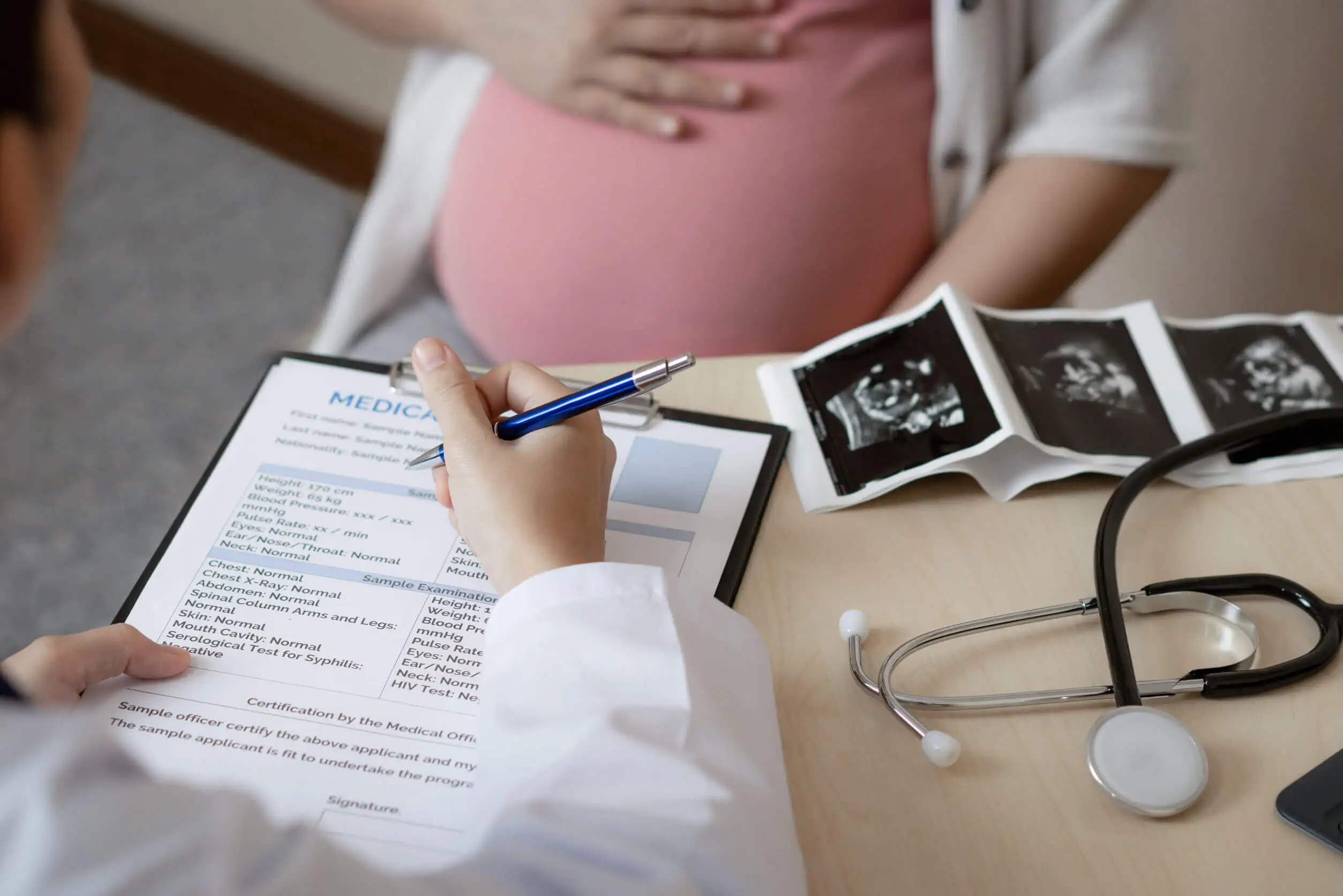A Brown Discharge During Pregnancy: What Does it Mean?

A brown discharge during pregnancy is a relatively common symptom. What’s important to ensure is that it isn’t accompanied by other symptoms, it doesn’t occur in large amounts, and that it doesn’t last more than three days.
That said, it’s best to seek a consultation with your doctor or gynecologist to rule out possible complications. Generally speaking, the discharge during the entire gestation period should be white. So, why can this alteration in color occur? Here are the possible causes.
A brown discharge during pregnancy
It’s estimated that 1 in 5 women have a brown discharge during pregnancy. It usually occurs when the fertilized egg implants in the wall of the uterus, i.e. at the beginning of pregnancy. In fact, it’s often confused with menstruation.
To be more precise, this colored fluid – which can also be seen as a dark red – is composed of old blood. However, its texture is lighter and its volume less intense than menstrual bleeding. Moreover, in most cases it lasts only a few hours.
However, if it lasts for several days or weeks, it becomes a reason for medical consultation. As a general rule, a brown discharge usually occurs in the first trimester of pregnancy. It shouldn’t cause any other symptoms such as pain or itching, nor should it have a strange odor or consistency.

Why does a brown discharge occur during pregnancy?
There are often two reasons for a brown discharge during pregnancy. The first is implantation. The fertilized egg must travel from the fallopian tubes to the uterus. There it attaches to the lining of the uterus, which can cause some detachment, thus producing this fluid.
This process takes place between 7 and 14 days after conception. It’s usual that first there’s a pink discharge with a jelly-like consistency. This is followed by a brownish discharge. This is scarce, has a smooth consistency, and doesn’t have a bad odor.
The second reason why it usually occurs is hormonal change. Some women have spotting throughout pregnancy because of this. The discharge is very light and there are no other symptoms.
However, if the discharge occurs simultaneously with symptoms such as pain, itching, fever, or strange changes in consistency, it may be caused by one of the following problems.
Infection
Symptoms of an STD or urinary tract infections can cause a brown discharge during pregnancy. In this case, it occurs with other symptoms such as pain or burning during urination, discomfort in the pelvic area, itching, and foul odor.
Placental abruption
In some cases, this symptom is a sign that the placenta has detached prematurely. This occurs during the third trimester of pregnancy. In these cases, the placenta is very low and the blood vessels of its upper layer are damaged. For this reason, the discharge is stained brown.
Uterine fibroids
Uterine fibroids are benign tumors that lodge in the uterus. They have many blood vessels and are sometimes located in such a way that they can bleed easily.
Ectopic pregnancy
An ectopic pregnancy occurs when the implantation of the embryo occurs outside the uterus. One of the symptoms of this condition is a brown discharge or bleeding outside the menstrual period. In addition, there’s severe abdominal pain, extreme tenderness in the pelvic area, and a feeling of heaviness in the vagina.
Miscarriage
Brown discharge during pregnancy can also be a sign of a miscarriage. This usually occurs before the 20th week and is accompanied by symptoms such as severe abdominal pain, loss of fluid from the vagina without odor, fever and chills.
Other causes of brown discharge during pregnancy
- Another possible cause of brown discharge during pregnancy is genital trauma. This often occurs during sexual intercourse when the penis hits against the wall of the cervix. This causes light bleeding that gives the vaginal discharge that hue.
- Polyps in the uterus also have the potential to cause this symptom.
- Also, a brown discharge could be a sign of cervical cancer. It doesn’t affect pregnancy unless it’s at an advanced stage.
You might also be interested in: Five Home Remedies to Control Vaginal Discharge
Types of brown discharge during pregnancy and their meaning
The meaning of a brown discharge during pregnancy varies, depending on the time of gestation at which it occurs and other circumstances. Let’s take a closer look.
First trimester of pregnancy
A brown discharge during pregnancy is most common in the first trimester; specifically, in early pregnancy. If it’s accompanied by other symptoms, particularly pain, it could be a sign of an ectopic pregnancy or a risk of miscarriage.
Second trimester
A brown discharge is unusual during pregnancy in the second trimester. The risk of miscarriage persists, but is very low. If there’s pain, we’re most likely talking about placental abruption. This should be attended to by the doctor as soon as possible.
Third trimester
During the third trimester, there’s a greater chance of getting an infection that leads to a brown discharge. It’s also possible for hormonal changes to cause cervical erosion that causes the discharge. This isn’t usually a cause for concern.
In addition to the above, towards the end of pregnancy, a mucus plug is expelled, signifying that it’s time to give birth.
After intercourse
The cervix is more sensitive during pregnancy. That’s why, even if you’re very careful, it isn’t uncommon to have slight bleeding after intercourse, which occurs as a brown discharge. This is nothing to worry about, unless there are other symptoms.
Twin pregnancy
Ultimately, this symptom is more frequent when there is more than one baby in gestation. This is normal, as long as the discharge doesn’t have an unpleasant odor or strange texture. There should also be no other symptoms.
When to seek help?
As a general rule, a brown discharge during pregnancy shouldn’t be heavy. Neither should it have unusual characteristics such as a bad odor, lumpy texture, or excessive thickness. If it’s quite light, smooth, and lasts for a few hours or a couple of days, there’s no need to consult a doctor.
Three fundamental variables should be taken into account in this matter:
- Amount. A large amount of brown discharge warrants a consultation with your health care provider.
- Duration. More than three days of discharge is a warning sign.
- Time of onset. As a general rule, if the discharge appears after the first trimester, it’s best to see a professional.

Read more: Is Pregnancy Possible with Amenorrhea?
What to remember?
A brown discharge during pregnancy isn’t a worrying sign on its own. Between a quarter and a fifth of women have this symptom, especially in early pregnancy. So don’t panic or presume that something is wrong.
That said, when the symptom occurs in the second or third trimester of pregnancy, it’s best to consult your doctor, even if there are no other symptoms. It’s also advisable to do so if you are in any way concerned about the situation.
All cited sources were thoroughly reviewed by our team to ensure their quality, reliability, currency, and validity. The bibliography of this article was considered reliable and of academic or scientific accuracy.
- Kim SM, Kim JS. A Review of Mechanisms of Implantation. Dev Reprod. 2017;21(4):351-359. doi:10.12717/DR.2017.21.4.351
- Khaskheli, Meharunnissa et al. “Vaginal discharge during pregnancy and associated adverse maternal and perinatal outcomes.” Pakistan journal of medical sciences vol. 37,5 (2021): 1302-1308. doi:10.12669/pjms.37.5.4187
-
National Guideline Alliance (UK). Management of symptomatic vaginal discharge in pregnancy: Antenatal care: Evidence review T. London: National Institute for Health and Care Excellence (NICE); 2021 Aug. (NICE Guideline, No. 201.) Available from: https://www.ncbi.nlm.nih.gov/books/NBK573944/
This text is provided for informational purposes only and does not replace consultation with a professional. If in doubt, consult your specialist.








